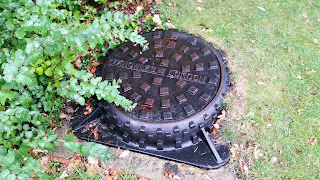I was on the last leg of my morning two-mile walk when I saw this nestling in a grassy verge. I'd never noticed it before.
'My goodness,' I thought, 'that's a handsome piece of ironwork.' It was a manhole cover. I stood back and admired the strong design on the lid. But I especially admired the nice curving rim, and the studs on it. Surely those served no functional purpose, and were just decoration? Their presence seemed surprising. And I liked the sturdy corner struts, again surely a matter of art rather than strict functionality? I whipped out my phone and took a shot.
It was 'only' a manhole cover, but I couldn't remember seeing one like this before. Nearly all manhole covers (and other street furniture like them) are buried flush into the ground, or the pavement, or the road, so that they are not trip hazards, or likely to damage the suspension of vehicles. This one wasn't. It was proud and unashamed. I wondered why it was exceptional. I also speculated on whether most manhole covers, if disinterred, would look like this one did.
Next morning - it was less than two hours ago, in fact - I found another example not far away, in a shared driveway. This one was buried flush to the tarmac:
It was clearly the same design. Both covers had KNOWLES LONDON on them - the maker, presumably. The one flush to the tarmac must be coeval with the houses nearly, suggesting that it might date from the 1940s or 1950s and be as much as seventy years old. And that argued that the near-pristine cover I first noticed was also that kind of age. Well, if so, these iron artifacts lasted very well!
My general curiosity about these manhole covers and their designs was now aroused. Surely there was more to them than met the eye. And there was. It was a subject for Local Historians to get their teeth into, and I quickly discovered a blog run by such a person, retired now, who had built up a collection of photographs of manhole covers not just from this country, but elsewhere in the world. Do have a look at this link: http://manholemiscellany.blogspot.co.uk/. And this Pinterest page: https://uk.pinterest.com/pin/135389532523248571/.
I learned that people use the 'industrial' designs of manhole covers as the basis for derived artworks, involving 'manhole rubbing'. Yes, really. See https://www.creativereview.co.uk/overlooked-the-art-of-the-humble-manhole-cover/.
Of course, if you are in the trade, or a lay person interested in the technicalities, there are websites that explain all about the different kinds and grades of manhole cover. For instance, see http://www.richardsbuildersmerchants.co.uk/choosing-the-right-manhole-cover/. And for a general grounding in the subject, Wikipedia at https://en.wikipedia.org/wiki/Manhole_cover.
The local history and art-potential aspects interest me. I think I'll add manhole covers to my list of photography subjects - at least for a while. I mean, the fascination may be short-lived and burn itself out fast. But you never know.
And what about drains?
That's got E.S.E. PHOENIX LEWES on it. Wow. Drains could be an amazing sideline. This could herald a whole new era. One could get very keen on this kind of thing.
However, I draw the line on getting down on my hands and knees in the middle of a road, and making a manhole-rubbing. That's asking for trouble.
skip to main |
skip to sidebar

Search my blog
Total Pageviews
Lucy Melford on Flickr
About Me

- Lucy Melford
- Sussex, United Kingdom
- This is really my autobiography, written as I go along. I'm getting older, more aware of how time is passing, and so much still to do and experience. I want to share what happens to me here, on my blog. I hope you find at least some of it interesting and enlightening.





